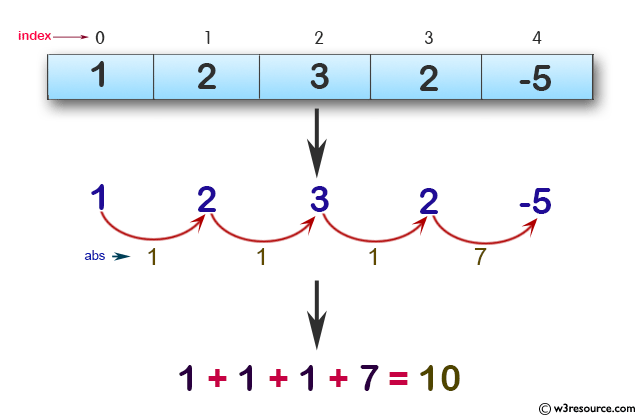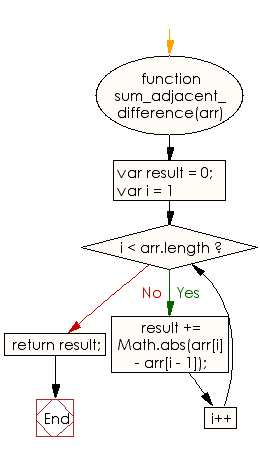JavaScript: Compute the sum of absolute differences of consecutive numbers of a given array of integers
JavaScript Basic: Exercise-96 with Solution
Sum of Absolute Differences of Consecutive Numbers
Write a JavaScript program to compute the sum of the absolute differences of consecutive numbers in a given array of integers.
Visual Presentation:

Sample Solution:
JavaScript Code:
// Function to calculate the sum of adjacent differences in an array
function sum_adjacent_difference(arr) {
var result = 0; // Variable to store the result
for (var i = 1; i < arr.length; i++) {
// Add the absolute difference between adjacent elements to the result
result += Math.abs(arr[i] - arr[i - 1]);
}
return result; // Return the final sum
}
console.log(sum_adjacent_difference([1, 2, 3, 2, -5])); // Example usage
Output:
10
Live Demo:
See the Pen javascript-basic-exercise-96 by w3resource (@w3resource) on CodePen.
Flowchart:

ES6 Version:
// Function to calculate the sum of absolute differences between adjacent elements in an array
const sum_adjacent_difference = (arr) => {
let result = 0; // Initialize the result variable to store the sum
// Iterate through the array starting from the second element
for (let i = 1; i < arr.length; i++) {
result += Math.abs(arr[i] - arr[i - 1]); // Add the absolute difference to the result
}
return result; // Return the final sum
};
console.log(sum_adjacent_difference([1, 2, 3, 2, -5])); // Example usage
For more Practice: Solve these Related Problems:
- Write a JavaScript program that computes the sum of the absolute differences between each pair of consecutive numbers in an array.
- Write a JavaScript function that iterates through an array and accumulates the absolute difference of every adjacent pair, then returns the total sum.
- Write a JavaScript program that handles both positive and negative numbers in an array while summing up the absolute differences between consecutive elements.
Go to:
PREV : Replace Numbers with Specified Value in Array.
NEXT : Shortest String to Convert into Palindrome.
Improve this sample solution and post your code through Disqus.
What is the difficulty level of this exercise?
Test your Programming skills with w3resource's quiz.
